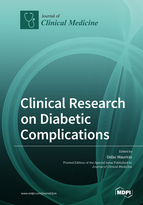Clinical Research on Diabetic Complications
A special issue of Journal of Clinical Medicine (ISSN 2077-0383). This special issue belongs to the section "Endocrinology & Metabolism".
Deadline for manuscript submissions: closed (10 May 2019) | Viewed by 56366
Special Issue Editor
2. Faculty of Medicine, University of Vic & Central University of Catalonia, Barcelona, Spain
3. Center for Biomedical Research on Diabetes and Associated Metabolic Diseases (CIBERDEM), Instituto de Salud Carlos III, 08041 Barcelona, Spain
Interests: diabetes mellitus; atherosclerosis; cardiovascular disease; retinopathy
Special Issues, Collections and Topics in MDPI journals
Special Issue Information
Dear Colleagues,
Diabetes mellitus is associated with the development of chronic complications as a result of long-term exposure to hyperglycemia. Additionally, other metabolic disturbances, especially associated with type 2 diabetes, contribute to an increased risk of chronic complications. In fact, these complications have an important impact on subjects affected by different diabetes types in terms of decreased quality of life and shorter life expectancy. Therefore, one of the main goals of diabetes treatment is the prevention and/or delay in the appearance and progression of the different complications.
Traditionally, in daily practice, clinicians classify these complications into two types depending on the size of the affected vessels, i.e., microangiopathy and macroangiopathy. On one hand, microangiopathy includes retinopathy, neuropathy and nephropathy. On the other, macroangiopathy is mainly due to an accelerated process of atherosclerosis that leads to the clinical manifestations of cardiovascular disease: Ischemic heart disease, peripheral artery disease and cerebrovascular. However, in recent years, it is evident that diabetes leads not only to vascular complications. It is now well accepted that hyperglycemia is associated to other complications like non-alcoholic fatty liver disease, cardiomyopathy, dementia, and an increased incidence of different types of cancer.
The current Special Issue of JCM invites clinical researchers to contribute original research manuscripts and review articles related to any clinical aspects of the natural history, epidemiology, prevention and management of chronic complications of diabetes mellitus.
Dr. Didac Mauricio
Guest Editor
Manuscript Submission Information
Manuscripts should be submitted online at www.mdpi.com by registering and logging in to this website. Once you are registered, click here to go to the submission form. Manuscripts can be submitted until the deadline. All submissions that pass pre-check are peer-reviewed. Accepted papers will be published continuously in the journal (as soon as accepted) and will be listed together on the special issue website. Research articles, review articles as well as short communications are invited. For planned papers, a title and short abstract (about 100 words) can be sent to the Editorial Office for announcement on this website.
Submitted manuscripts should not have been published previously, nor be under consideration for publication elsewhere (except conference proceedings papers). All manuscripts are thoroughly refereed through a single-blind peer-review process. A guide for authors and other relevant information for submission of manuscripts is available on the Instructions for Authors page. Journal of Clinical Medicine is an international peer-reviewed open access semimonthly journal published by MDPI.
Please visit the Instructions for Authors page before submitting a manuscript. The Article Processing Charge (APC) for publication in this open access journal is 2600 CHF (Swiss Francs). Submitted papers should be well formatted and use good English. Authors may use MDPI's English editing service prior to publication or during author revisions.
Keywords
- Diabetic macroangiopathy
- Cardiovascular disease
- Heart disease
- Cerebrovascular disease
- Peripheral artery disease
- Diabetic foot disease
- Diabetic microangiopathy
- Diabetic retinopathy
- Diabetic kidney disease
- Diabetic neuropathy







